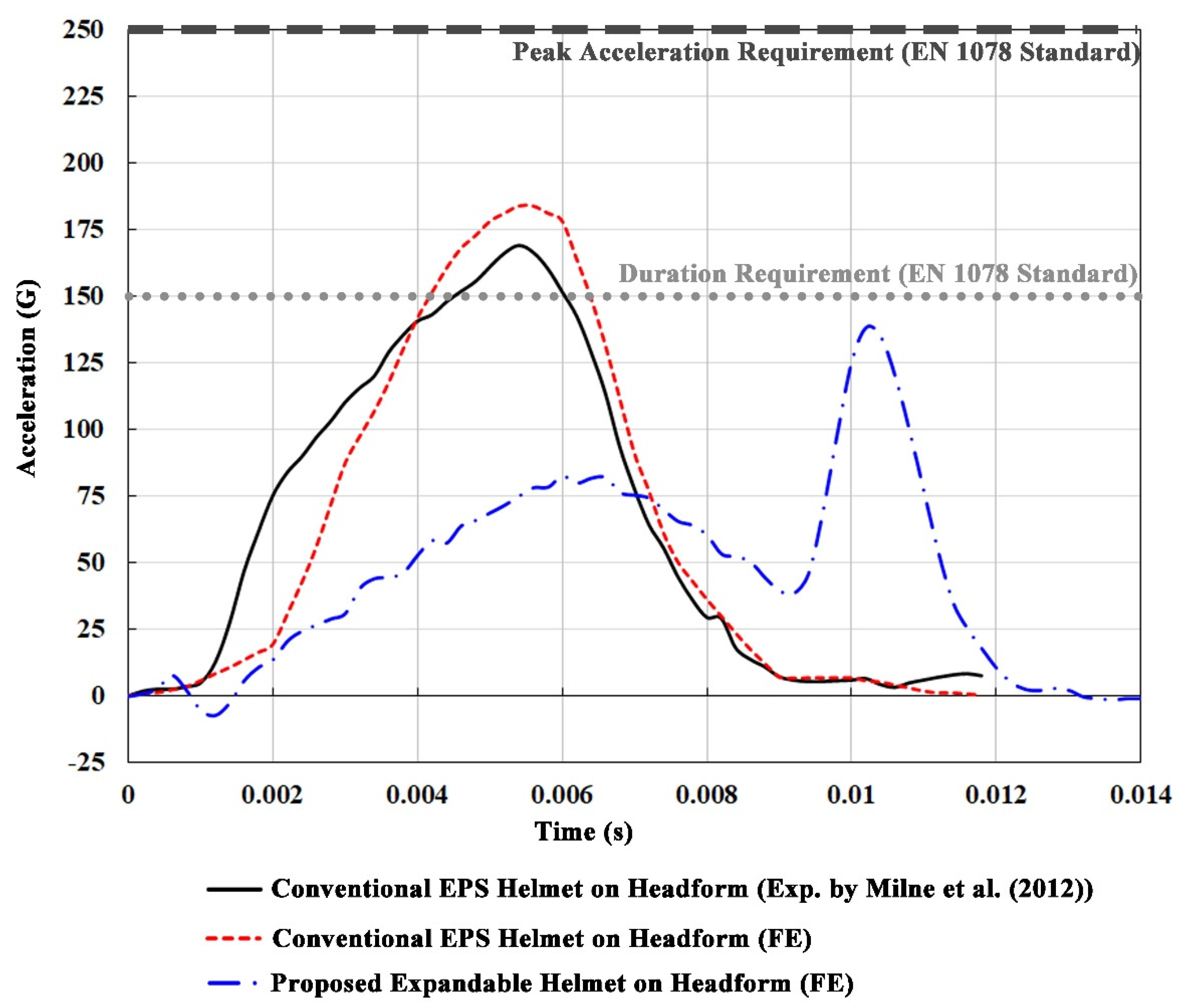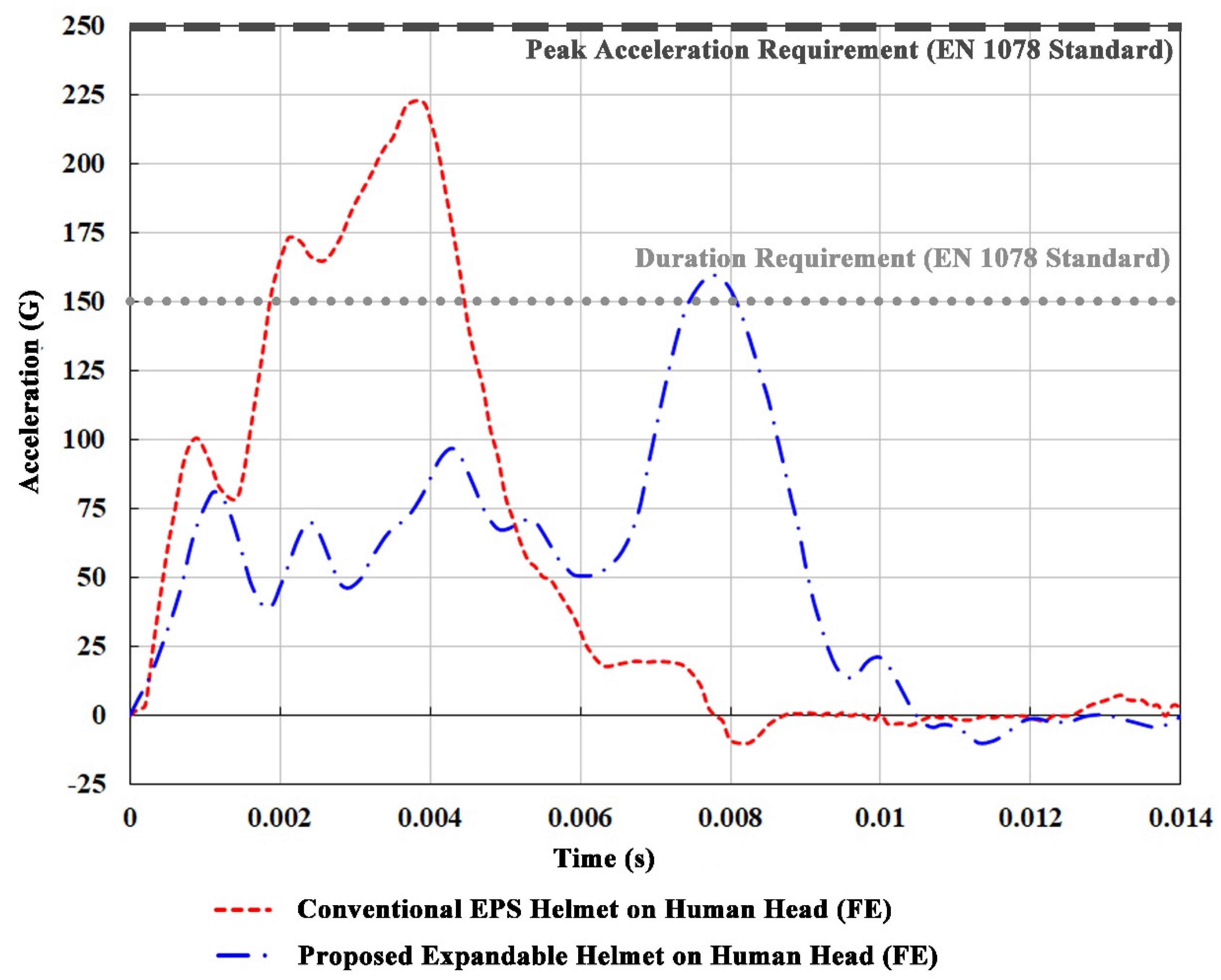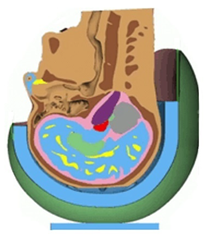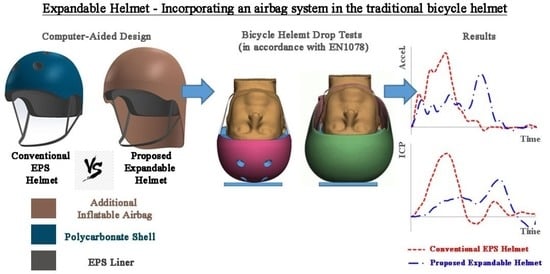A Biomechanical Evaluation of a Novel Airbag Bicycle Helmet Concept for Traumatic Brain Injury Mitigation
Abstract
:1. Introduction
2. Materials and Methods
2.1. The Finite Element Model
| Components | Material Properties | Thickness [mm] | LS-DYNA Material Model | Ref. |
|---|---|---|---|---|
| Retention Strap (PET) | ρ = 1400 kg/m3 E = 1000 MPa ν = 0.44 | 1.5 | MAT_ELASTIC_001 | Milne et al. [32] |
| Liner (EPS) | ρ = 61.6 kg/m3 E = 28 MPa ν = 0.01 | 20 | MAT_ CRUSHABLE_FOAM_063 | Milne et al. [32] |
| Helmet Shell (PC) | ρ = 1055 kg/m3 E = 1500 MPa ν = 0.42 | 0.4 | MAT_ELASTIC_001 | Deck and Willinger [34] |
| Airbag Component (Nylon 6-6 or Polyamide 66) | ρ = 1000 kg/m3 E =100 MPa ν = 0.40 | 0.35 (fabric thickness) | MAT_FABRIC_034 | Avula et al. [35] |
| Anvil (Steel) | ρ = 7830 kg/m3 E =207,000 MPa ν = 0.30 | 24 | MAT_RIGID_ 020 | Sandberg et al. [36] |
| Headform (MgK1A) | ρ = 1740 kg/m3 E =44,800 MPa ν = 0.32 | N/A | MAT_RIGID_ 020 | SA/SNZ [37] |
2.2. Impact Simulation Environment, Interaction, Initial and Boundary Conditions
2.3. Injury Assessment and Evaluation Method
3. Results
3.1. Indirect Validation and Benchmarking against Experimental Impacts on the Ballast Headform
3.2. Injury Assessment Using a Validated Biofidelic Human Head and Brain Model
4. Discussion
5. Conclusions
Author Contributions
Funding
Institutional Review Board Statement
Informed Consent Statement
Conflicts of Interest
Appendix A

References
- WHO. Global Status Report on Road Safety 2018: Summary; WHO: Geneva, Switzerland, 2018; Available online: https://www.who.int/publications/i/item/9789241565684 (accessed on 25 October 2021).
- IIHS. Insurance Institute for Highway Safety Fatality Facts: Bicycles—2019; IIHS: Arlington, VA, USA, 2019; Available online: https://www.iihs.org/topics/fatality-statistics/detail/bicyclists (accessed on 25 October 2021).
- Høye, A. Bicycle helmets—To wear or not to wear? A meta-analyses of the effects of bicycle helmets on injuries. Accid. Anal. Prev. 2018, 117, 85–97. [Google Scholar] [CrossRef] [PubMed]
- Høye, A. Recommend or mandate? A systematic review and meta-analysis of the effects of mandatory bicycle helmet legislation. Accid. Anal. Prev. 2018, 120, 239–249. [Google Scholar] [CrossRef] [PubMed]
- Attewell, R.G.; Glase, K.; McFadden, M. Bicycle helmet efficacy: A meta-analysis. Accid. Anal. Prev. 2001, 33, 345–352. [Google Scholar] [CrossRef]
- Elvik, R. Publication bias and time-trend bias in meta-analysis of bicycle helmet efficacy: A re-analysis of Attewell, Glase and McFadden, 2001. Accid. Anal. Prev. 2011, 43, 1245–1251. [Google Scholar] [CrossRef] [PubMed]
- Dorsch, M.M.; Woodward, A.J.; Somers, R.L. Do bicycle safety helmets reduce severity of head injury in real crashes? Accid. Anal. Prev. 1987, 19, 183–190. [Google Scholar] [CrossRef]
- Olivier, J.; Walter, S.R.; Grzebieta, R.H. Long term bicycle related head injury trends for New South Wales, Australia following mandatory helmet legislation. Accid. Anal. Prev. 2013, 50, 1128–1134. [Google Scholar] [CrossRef] [Green Version]
- Cripton, P.A.; Dressler, D.M.; Stuart, C.A.; Dennison, C.R.; Richards, D. Bicycle helmets are highly effective at preventing head injury during head impact: Head-form accelerations and injury criteria for helmeted and unhelmeted impacts. Accid. Anal. Prev. 2014, 70, 1–7. [Google Scholar] [CrossRef] [PubMed]
- Bahrololoom, S.; Young, W.; Logan, D. Modelling injury severity of bicyclists in bicycle-car crashes at intersections. Accid. Anal. Prev. 2020, 144, 105597. [Google Scholar] [CrossRef] [PubMed]
- McNally, D.S.; Whitehead, S. A computational simulation study of the influence of helmet wearing on head injury risk in adult cyclists. Accid. Anal. Prev. 2013, 60, 15–23. [Google Scholar] [CrossRef] [PubMed]
- Bambach, M.R.; Mitchell, R.J.; Grzebieta, R.H.; Olivier, J. The effectiveness of helmets in bicycle collisions with motor vehicles: A case-control study. Accid. Anal. Prev. 2013, 53, 78–88. [Google Scholar] [CrossRef] [PubMed] [Green Version]
- Mills, N.J.; Gilchrist, A. The effectiveness of foams in bicycle and motorcycle helmets. Accid. Anal. Prev. 1991, 23, 153–163. [Google Scholar] [CrossRef]
- Mills, N.J.; Gilchrist, A. Finite-element analysis of bicycle helmet oblique impacts. Int. J. Impact Eng. 2008, 35, 1087–1101. [Google Scholar] [CrossRef]
- McIntosh, A.S.; Lai, A.; Schilter, E. Bicycle Helmets: Head Impact Dynamics in Helmeted and Unhelmeted Oblique Impact Tests. Traffic Inj. Prev. 2013, 14, 501–508. [Google Scholar] [CrossRef] [PubMed]
- McIntosh, A.; Curtis, K.; Rankin, T.; Cox, M.; Pang, T.; McCrory, P.; Finch, C. Associations between Helmet Use and Brain Injuries amongst Injured Pedal- and Motor-Cyclists: A Case Series Analysis of Trauma Centre Presentations. J. Australas. Coll. Road Saf. 2013, 24, 11–20. [Google Scholar]
- Corner, J.P.; Witney, C.W.; O’Rourke, N.; Morgan, D.E. Motorcycle and Bicycle Protective Helmets Requirements Resulting from a Post-Crash Study and Experimental Research: Prepared for Federal Office of Road Safety; Trove: Canberra, Australia, 1987. Available online: https://trove.nla.gov.au/work/13152660 (accessed on 25 October 2021).
- Hopes, P.D.; Chinn, B.P. Helmets: A new look at design and possible protection. In Proceedings of the International Research Council on the Biomechanics of Injury (IRCOBI) Conference, Stockholm, Sweden, 13–15 September 1989. [Google Scholar]
- Morgan, D.E.; Szabo, L.S. Improved Shock Absorbing Liner for Helmets; Australian Transport Safety Bureau: Canberra, Australia, 2001. Available online: https://www.infrastructure.gov.au/sites/default/files/migrated/roads/safety/publications/2001/pdf/helmet_liner.pdf (accessed on 25 October 2021).
- Meaney, D.F.; Smith, D.H. Biomechanics of Concussion. Clin. Sports Med. 2011, 30, 19–31. [Google Scholar] [CrossRef] [Green Version]
- Willinger, R.; Deck, C.; Halldin, P.; Otte, D. Towards advanced bicycle helmet test methods. In Proceedings of the The 3rd International Cycling Safety Conference (ICSC2014), Gothenburg, Sweden, 18–19 November 2014. [Google Scholar]
- Najmon, J.C.; Dehart, J.; Wood, Z.M.; Tovar, A. Cellular Helmet Liner Design through Bio-inspired Structures and Topology Optimization of Compliant Mechanism Lattices. SAE Int. J. Transp. Saf. 2018, 6, 217–235. [Google Scholar] [CrossRef]
- Cernicchi, A.; Galvanetto, U.; Iannucci, L. Virtual modelling of safety helmets: Practical problems. Int. J. Crashworthiness 2008, 13, 451–467. [Google Scholar] [CrossRef]
- Gohel, G.; Bhudolia, S.K.; Elisetty, S.B.S.; Leong, K.F.; Gerard, P. Development and impact characterization of acrylic thermoplastic composite bicycle helmet shell with improved safety and performance. Compos. Part B Eng. 2021, 221, 109008. [Google Scholar] [CrossRef]
- Kassar, S.; Siblini, S.; Wehbi, B.; Abro, O.; Shehadeh, M. Towards a Safer Design of Helmets: Finite Element and Experimental Assessment. In Proceedings of the ASME 2016 International Mechanical Engineering Congress and Exposition, Phoenix, AZ, USA, 13–17 November 2016. [Google Scholar]
- Kiran Totla, S.; Pillai, A.M.; Chetan, M.; Warad, C.; Vinodkumar, S.K.; Patil, A.Y.; Kotturshettar, B.B. Analysis of helmet with coconut shell as the outer layer. Mater. Today Proc. 2020, 32, 365–373. [Google Scholar] [CrossRef]
- Mips Helmet Technology & Why You Want It: Outdoor Divas. Available online: https://outdoordivas.com/blog/mips-helmet-technology-why-you-want-it/ (accessed on 1 October 2020).
- Bliven, E.; Rouhier, A.; Tsai, S.; Willinger, R.; Bourdet, N. A novel strategy for mitigation of oblique impacts in bicycle helmets. J. Forensic Biomed. 2019, 10, 8. [Google Scholar] [CrossRef]
- Kurt, M.; Laksari, K.; Kuo, C.; Grant, G.A.; Camarillo, D.B. Modeling and Optimization of Airbag Helmets for Preventing Head Injuries in Bicycling. Ann. Biomed. Eng. 2017, 45, 1148–1160. [Google Scholar] [CrossRef] [PubMed]
- Stigson, H.; Rizzi, M.; Ydenius, A.; Engström, E.; Kullgren, A. Consumer Testing of Bicycle Helmets. In Proceedings of the International Research Council on the Biomechanics of Injury (IRCOBI) Conference, Antwerp, Belgium, 13–15 September 2017. [Google Scholar]
- Tse, K.M.; Tan, L.B.; Lee, S.J.; Lim, S.P.; Lee, H.P. Development and validation of two subject-specific finite element models of human head against three cadaveric experiments. Int. J. Numer. Methods Biomed. Eng. 2014, 30, 397–415. [Google Scholar] [CrossRef]
- Milne, G.; Deck, C.; Carreira, R.P.; Allinne, Q.; Willinger, R. Development and validation of a bicycle helmet: Assessment of head injury risk under standard impact conditions. Comput. Methods Biomech. Biomed. Eng. 2012, 15, 309–310. [Google Scholar] [CrossRef] [PubMed]
- Pamuk, G. Airbags: An Overview. E-J. New World Sci. Acad. 2008, 3, 225–231. [Google Scholar]
- Deck, C.; Willinger, R. Multi-directional optimisation against biomechanical criteria of a head–helmet coupling. Int. J. Crashworthiness 2006, 11, 561–572. [Google Scholar] [CrossRef]
- Avula, X.J.R.; Kaleps, I.; Mysore, P. Nonlinear Finite Element Modeling of an Airbag during Inflation and Impact; Report No. AFRL-HE-WP-TR-1999-0176:1999; US Air Force Research Laboratory: Montgomery, OH, USA, 1999; Available online: https://apps.dtic.mil/sti/pdfs/ADA370773.pdf (accessed on 25 October 2021).
- Sandberg, M.; Tse, K.M.; Tan, L.B.; Lee, H.P. A computational study of the EN 1078 impact test for bicycle helmets using a realistic subject-specific finite element head model. Comput. Methods Biomech. Biomed. Eng. 2018, 21, 684–692. [Google Scholar] [CrossRef] [PubMed] [Green Version]
- SA/SNZ. Methods of Testing Protective Helmets—Determination of Impact Energy Attenuation—Helmet Drop Test. In CS-097 (Testing of Helmets and Visors) Standards Australia; Standards Australia: Sydney, Australia, 2007; Available online: https://www.standards.org.au/standards-catalogue/sa-snz/consumer/cs-097/as-slash-nzs--2512-dot-3-dot-1-2007 (accessed on 25 October 2021).
- Kleiven, S.; Hardy, W. Correlation of an FE Model of the Human Head with Local Brain Motion-Consequences for Injury Prediction. Stapp Car Crash J. 2002, 46, 123–144. [Google Scholar] [PubMed] [Green Version]
- Create an LS-DYNA Input Deck for a Simple Inflatable Airbag. Available online: https://www.simware.com.tw/lspp/tutorial/3_Model_tutorial/3_2_inflatable_Airbag/index.html (accessed on 16 August 2020).
- Takhounts, E.G.; Craig, M.J.; Moorhouse, K.; McFadden, J.; Hasija, V. Development of brain injury criteria (BrIC). Stapp Car Crash J. 2013, 57, 243–266. [Google Scholar]
- Mertz, H.; Prasad, P.; Nusholtz, G. Head Injury Risk Assessment for Forehead Impacts; SAE Technical Paper 960099; SAE International: Warrendale, PA, USA, 1996; Available online: https://www.sae.org/publications/technical-papers/content/960099/ (accessed on 25 October 2021).
- Fahlstedt, M.; Halldin, P.; Kleiven, S. The protective effect of a helmet in three bicycle accidents—A finite element study. Accid. Anal. Prev. 2016, 91, 135–143. [Google Scholar] [CrossRef] [PubMed]
- Tse, K.M.; Lim, S.P.; Tan, V.B.C.; Lee, H.P. A Review of Head Injury and Finite Element Head Models. Am. J. Eng. Technol. Soc. 2014, 1, 28–52. [Google Scholar]
- Tse, K.M. Development of a Realistic Finite Element Model of Human Head and Its Applications to Head Injuries Singapore; National University of Singapore: Singapore, 2013. [Google Scholar]
- Holbourn, A. Mechanics of head injuries. Lancet 1943, 2, 438–441. [Google Scholar] [CrossRef]
- Johnston, I.H.; Rowan, J.O. Raised intracranial pressure and cerebral blood flow. J. Neurol. Neurosurg. Psychiatry 1974, 37, 585–592. [Google Scholar] [CrossRef] [Green Version]
- Bullock, R.; Graham, D.I. Non-penetrating injuries of the head. In Scientific Foundations of Trauma; Butterworth-Heinemann: Oxford, UK, 1997; pp. 101–126. [Google Scholar]





| Case No. | Impact Scenario & Configuration | |
|---|---|---|
| 1 | Conventional EPS Bicycle Helmet on Ballast Headform |  |
| 2 | Proposed Expandable Bicycle Helmet on Ballast Headform |  |
| 3 | Conventional EPS Bicycle Helmet on Human Head |  |
| 4 | Proposed Expandable Bicycle Helmet on Human Head |  |
Publisher’s Note: MDPI stays neutral with regard to jurisdictional claims in published maps and institutional affiliations. |
© 2021 by the authors. Licensee MDPI, Basel, Switzerland. This article is an open access article distributed under the terms and conditions of the Creative Commons Attribution (CC BY) license (https://creativecommons.org/licenses/by/4.0/).
Share and Cite
Tse, K.M.; Holder, D. A Biomechanical Evaluation of a Novel Airbag Bicycle Helmet Concept for Traumatic Brain Injury Mitigation. Bioengineering 2021, 8, 173. https://doi.org/10.3390/bioengineering8110173
Tse KM, Holder D. A Biomechanical Evaluation of a Novel Airbag Bicycle Helmet Concept for Traumatic Brain Injury Mitigation. Bioengineering. 2021; 8(11):173. https://doi.org/10.3390/bioengineering8110173
Chicago/Turabian StyleTse, Kwong Ming, and Daniel Holder. 2021. "A Biomechanical Evaluation of a Novel Airbag Bicycle Helmet Concept for Traumatic Brain Injury Mitigation" Bioengineering 8, no. 11: 173. https://doi.org/10.3390/bioengineering8110173
APA StyleTse, K. M., & Holder, D. (2021). A Biomechanical Evaluation of a Novel Airbag Bicycle Helmet Concept for Traumatic Brain Injury Mitigation. Bioengineering, 8(11), 173. https://doi.org/10.3390/bioengineering8110173








